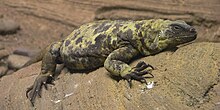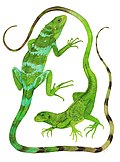San Esteban chuckwalla
| San Esteban chuckwalla[1] | |
|---|---|

| |
| Scientific classification | |
| Kingdom: | |
| Phylum: | |
| Class: | |
| Order: | |
| Suborder: | |
| Family: | |
| Genus: | |
| Species: | S. varius
|
| Binomial name | |
| Sauromalus varius Dickerson, 1919
| |
The San Esteban chuckwalla (Sauromalus varius) (also known as the Piebald Chuckwalla) is a species of chuckwalla belonging to the Iguanidae family endemic to San Esteban Island in the Sea of Cortés. It is the largest of the five species of Chuckwallas and the most endangered.
Taxonomy and etymology
The generic name, sauromalus, is a combination of two Ancient Greek words:σαῦρος (sauros) meaning "lizard". and ομαλυς (omalus) meaning "flat".[2] Its specific name varius is Latin for "speckled," in reference to the Chuckwalla's mottled coloration.[3][4] It was first described by American herpetologist Mary C. Dickerson in 1919.[5]
The common name Chuckwalla derives from the Shoshone word "tcaxxwal" or Cahuilla "caxwal", transcribed by Spaniards as "chacahuala". The Seri people named the originally named the island for this species:Coftécöl lifa or the Peninsula of the Giant Chuckwalla.[6]
Distribution and habitat
The San Esteban chuckwalla is endemic to San Esteban Island in the Sea of Cortés.[3] While it is abundant on this small island, it occurs naturally nowhere else and is protected under the Endangered Species Act. At one time the Seri translocated populations of this lizard to other islands in the Sea of Cortés as a food item, however, none of these populations have survived beyond the original population found on San Esteban.[6]
Description
The San Esteban chuckwalla is the largest species of Chuckwalla reaching 24 inches (610 mm) in body length, 76 centimetres (30 in) overall length and weighing up to 1.4 kilograms (3.1 lb).[3] It is considered a gigantic species as it is 3 to 4 times the size of its mainland counterparts. Their skin is gray with tan to yellow patches over their entire bodies, and their faces are gray to black. Females are duller in appearance with less patches. Their colorations provide almost perfect camouflage against some of their predators.
Human contact
The Seri considered this species of chuckwalla an important food item due to its large size.[7] The tribe of Seri who once inhabited San Esteban Island referred to themselves as Coftécöl Comcáac, "People of the Giant Chuckwalla" and named the island for this species.[6]
The San Esteban chuckwalla is an endangered species due to hunting from the Seri and the introduction of feral animals such as rats and mice which prey upon the chuckwalla's eggs and feral dogs and cats which prey upon the lizards.[6]
There is an In Situ chuckwalla captive breeding program in Punta Chueca, a Seri village on San Esteban.[6] A successful Ex situ program has also been in place at the Arizona-Sonora Desert Museum since 1986.
References
- ^ "Sauromalus varius". Integrated Taxonomic Information System. 26 September.
{{cite web}}: Check date values in:|date=and|year=/|date=mismatch (help) - ^ Schwenkmeyer, Dick. "Sauromalus ater Common Chuckwalla". Field Guide. San Diego Natural History Museum. Retrieved 17 September 2008.
- ^ a b c Case, T. J. (1982). Ecology and evolution of insular gigantic chuckwallas, Sauromalus hispidus and Sauromalus varius. Park Ridge, New Jersey: Noyes Publications. pp. 184–212. ISBN 0815509170.
{{cite book}}:|work=ignored (help) - ^ Hollingsworth, Bradford D. (2004). The Evolution of Iguanas an Overview and a Checklist of Species. University of California Press. pp. 43–44. ISBN 9780520238541.
{{cite book}}:|work=ignored (help) - ^ Dickerson, M. C. (1919). Diagnoses of twenty-three new species and a new genus of lizards from Lower California. Bulletin of the American Museum of Natural History. 41 (10): 461-477
- ^ a b c d e Nabhan, Gary (2003). Singing the Turtles to Sea: The Comcáac (Seri) Art and Science of Reptiles. University of California Press. p. 350. ISBN 0520217314.
- ^ Richard Felger and Mary B. Moser (1985) People of the desert and sea: ethnobotany of the Seri Indians Tucson: University of Arizona Press.


